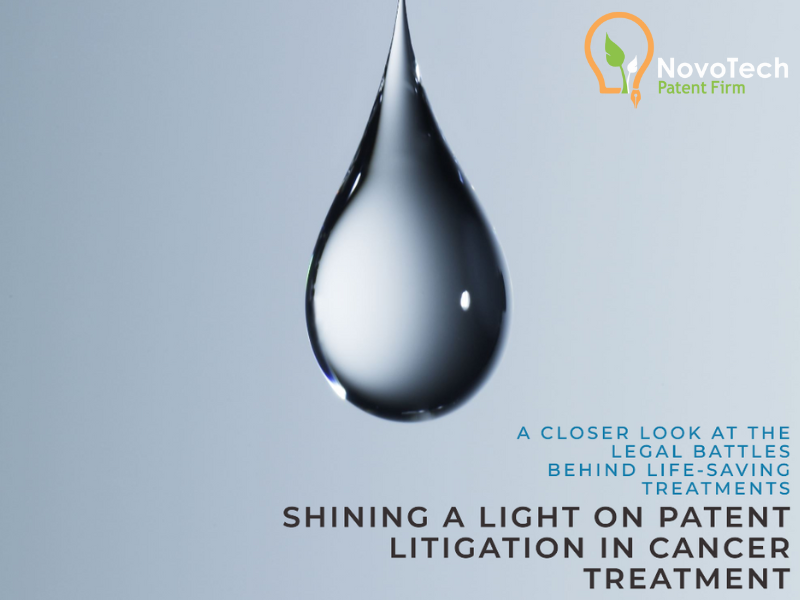
Patent Litigation Spotlight in Cancer Treatment
By Babak Akhlaghi on August 9, 2024. Patent litigation cases often read like a legal thriller, filled with twists, turns, and high-stakes drama. One recent case that exemplifies this narrative is the patent dispute between Natera and NeoGenomics. This case, decided by the U.S. Court of Appeals for the Federal Circuit on July 12, 2024, offers a fascinating glimpse into the complex world of intellectual property rights and the fierce battles in patent litigation that can ensue over innovative technologies. Natera, Inc. v. NeoGenomics Laboratories, Inc. Case No. 24-1324 (Fed. Cir. July 12, 2024) (Moore, CJ; Taranto, Chen, JJ.)
The Players
Natera, Inc. and NeoGenomics are healthcare companies specializing in oncology testing. They both produce products for early cancer relapse detection. Natera holds two patents, U.S. Patent Nos. 11,519,035 and 11,530,454, issued in December 2022. The ‘035 patent covers methods for amplifying targeted genetic material, like cfDNA, while reducing non-targeted material amplification. The ‘454 patent focuses on detecting genetic variations that indicate diseases or recurrences, such as ctDNA.
Natera’s Signatera product utilizes these patented methods. NeoGenomics offers a competing product called RaDaR. Both Signatera and RaDaR identify ctDNA in the bloodstream to evaluate cancer treatment effectiveness and recurrence risk. These tests are tumor-informed MRD tests, designed using a patient’s genetic information from a tumor biopsy. Doctors often prefer tumor-informed tests due to their personalized and potentially higher sensitivity compared to tumor-naïve tests.
The Core of the Dispute
Natera filed a patent lawsuit against NeoGenomics, claiming that the RaDaR assay infringes on the ’035 and ’454 patents. They requested a preliminary injunction, which the district court granted, concluding that Natera likely succeeded on the merits of at least its ’035 patent infringement claim.
The preliminary injunction is a big deal in patent cases because it prevents a competitor, here NeoGenomics, from making, using, selling, or offering the RaDaR assay. It also prohibits the promotion, advertising, marketing, servicing, distributing, or supplying of RaDaR to avoid inducing infringement. Exceptions are allowed for patients currently using RaDaR and for completed or ongoing research projects, studies, and clinical trials. This represents a significant profit loss and market share for NeoGenomics, while simultaneously providing a substantial profit gain and expanded customer base for Natera. Naturally, NeoGenomics appealed the district court’s decision to the Federal Circuit, this is were all patent cases go for final decision as Supreme Court rarely grants review of patent decisions.
The Court’s Ruling
The Federal Circuit’s opinion offers a detailed analysis of patent law, focusing on the scope and validity of the claims in question.
To secure a preliminary injunction, a party must demonstrate: (1) likelihood of success on the merits, (2) likelihood of suffering irreparable harm without the injunction, (3) that the balance of equities tips in their favor, and (4) that the injunction serves the public interest. NeoGenomics challenges the district court’s analysis on each requirement.
Key factors of the Court’s decision include:
Likelihood of Success:
To show likelihood of success, a patentee must likely prove infringement and that their claim will withstand challenges to validity and enforceability. The Federal Circuit agreed with the district court found that Natera made a strong case that the RaDaR test infringes the ’035 patent.
Validity of the Patents:
The Court also looked at non-obviousness of Natera’s patents. NeoGenomics argued that the district court used the wrong legal standard for obviousness. However, the Court disagreed, stating that NeoGenomics provided only conclusory arguments without substantial support. The Court found no error in its application of the standard for assessing validity challenges.
Irreparable Harm:
The Court also agreed with the lower court’s determination that Natera demonstrated a likelihood of irreparable harm due to, among other factors, direct competition with NeoGenomics.
Public Interest:
This is particularly crucial when addressing significant issues like cancer. Therefore, before granting such an extraordinary measure in a patent litigation, courts must balance the patentee’s rights against any potential adverse effects on the public. They need to determine whether the preliminary injunction in a patent litigation would harm the public. In this case, however, the Court concluded that the public interest favored the injunction. Since Signatera is clinically validated for the same cancers as RaDaR, patients needing a tumor-informed MRD test can access it through Natera. Additionally, the Court found that Natera has sufficient capacity to meet the increased demand.
Therefore, the Court agreed that the lower court’s findings supported the issuance of a preliminary injunction against NeoGenomics.
Conclusion
This case serves as a compelling example of the complexities and high stakes involved in patent lawsuits, particularly in the rapidly evolving healthcare sector. The Federal Circuit’s detailed analysis underscores the importance of securing robust patent protection and effectively demonstrating the key criteria for a preliminary injunction. This case not only highlights the strategic significance of intellectual property rights in maintaining competitive advantage but also illustrates the potential market shifts that can result from legal decisions in patent disputes. As the healthcare industry continues to innovate, the outcomes of such cases will undoubtedly shape the landscape of technological advancements and commercial success.
Stay Ahead of the Curve with Expert Insights!
Want more valuable tips on navigating patent law and protecting your intellectual property? Join our free weekly newsletter for the latest updates, expert advice, and exclusive content straight to your inbox. Subscribe today and never miss out on essential information that can make all the difference in your patent journey! Subscribe on LinkedIn